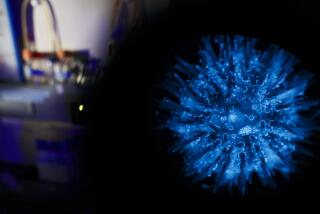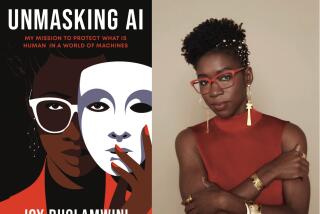Secrets of Life Might Be Revealed in a Digital Format
Exactly 50 years ago, a Nobel laureate physicist published a tiny book whose title asked a simple question: “What Is Life?”
Erwin Schrodinger, a creator of the quantum physics that was then leading the world inexorably toward the atomic bomb, wondered what role his science could play in explaining the nature of living things. “How can the events in space and time which take place within the spatial boundary of a living organism,” he asked, “be accounted for by physics and chemistry?”
Denying any hints of once-trendy “vitalism” or mystic rationales, Schrodinger boldly asserted that “the obvious inability of present-day physics and chemistry to account for such events is no reason at all for doubting that they can be accounted for by those sciences.” As the war ended, Schrodinger’s book--based on his 1943 Dublin lectures--appealed to physicists who wanted to turn their talents away from weapons of destruction and toward the understanding of life. The book strongly influenced the imaginations and research agendas of a generation of young scientists--including such future Nobel laureates as Francis Crick, James Watson and Jacques Monod. “What Is Life?” framed the questions scientists would be answering for the rest of the century.
But the book was also a symbol of a research effort that may ultimately prove every bit as important as the Manhattan Project.
Throughout the 1930s, the Rockefeller Foundation--then the most innovative funder of basic scientific research--believed that physicists held the intellectual keys to creating breakthroughs in the life sciences. Under the direction of Warren Weaver, the Foundation encouraged such physicists as Max Delbruck and Leo Szilard to bring their mind-sets to the problems of biology.
In effect, the Rockefeller Foundation invested millions to bring the culture and tools of physics to the domain of life. These physicists redefined the vocabularies of the life sciences and created a new scientific subculture.
The Rockefeller-funded Delbruck, for example, launched the Phage Group of physics-influenced researchers that explored the genetics of bacterial viruses. The youngest member of that group? James Watson, who became a co-discoverer of the double helix.
These were the institutional beginnings of molecular biology and they seamlessly led to the cracking of the genetic code and the emergence of biotechnology as an industry. The roots of innovations from mapping the human genome to our tentative forays in gene therapy thus reach back directly to the programs initiated in the 1930s, and the questions articulated by Schrodinger.
Now there’s no book today comparable to “What Is Life?” nor any research foundations seeking to create new subcultures of science. But it’s clear that, just as physics stood ready to transform biology half a century ago, there are similar opportunities to transform the life sciences today.
The physicists have had their turn. Who’s next? Who should be next? What does biology now need?
“We need computer science and metaphors from mathematics to get to the next level of understanding,” asserts Dr. Lee Hood, the Gates Professor and Chairman of the Molecular Biology Department at the University of Washington. Yes, that’s Gates as in Bill Gates, the chairman of Microsoft, who both endowed the chair and played an essential role in recruiting Hood from Caltech to the University of Washington.
Hood is enamored of the potential of digital technologies to detect and create intelligible patterns from the reams of data generated by such initiatives as the Human Genome Project.
“There are enormous amounts of data to analyze and we need both the tools and the theories to do it,” Hood says. “That’s why I see theoretical biology becoming so important. We have all this two-dimensional data from chromosomes and three-dimensional data from the structure of proteins and multidimensional data from complex systems of interaction--like how the neurons of the brain interact to give us consciousness. . . . What we don’t have are the theories or the mathematics that help pattern this data. We need to marry biology with mathematics and computer modeling.”
“Computer modeling is vital,” agrees Caltech History of Science Professor Daniel Kevles, who wrote “The Physicists,” a definitive history of physicists in the United States, and who now explores the culture of the life sciences. “Computer modeling (emulation) of cellular processes strikes me as a potentially important opportunity. The cell is a very complicated place; there are a lot of things going on at the same time. How we move out into the cell from the genome is very important. . . . The field of molecular biology needs more biologically informed software people.”
It’s not enough to have biologists try to build computer models and simulations of molecular biology, a common-enough practice today. Rather, there’s a need to get the world’s best mathematicians and modelers to learn molecular biology.
Hood, who wants to launch a Center for Computational Biology, thinks it would be “great” if the National Institutes of Health, the National Science Foundation or private foundations would aggressively fund mathematicians and computer scientists to come into biology in the 1990s the way the Rockefeller Foundation paid for physicists to come into biology over 50 years ago. “The NIH is just beginning to understand this,” he says.
Might an influx of mathematicians and computer modelers into biology have an impact comparable to that of the physicists? Will our understanding of life be marginally improved or fundamentally transformed if our abilities to digitally model and calculate life processes radically change?
Perhaps a new realm of “bio-informatics”--a science and technology of managing, modeling and manipulating molecular biological data--could lead to the biggest industry yet: an industry that merges computer software with medical diagnoses and therapy.
If the next 50 years hope to see the same sort of advances in biology as the last 50, society will have to make a serious investment in the new technologies of bio-informatics.






